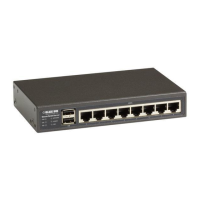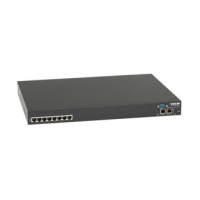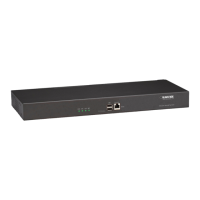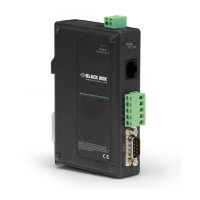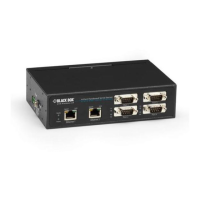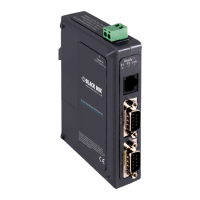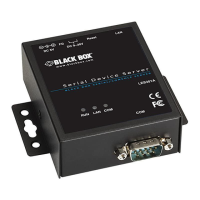Do you have a question about the Black Box LES1516A and is the answer not in the manual?
Lists the Black Box console server product models covered in this manual.
Identifies the target audience for this user manual.
Describes the structure and organization of the Black Box User Manual.
Defines the two classes of users supported by the console server: Administrators and Users.
Explains how to configure and monitor the console server using the Black Box Management Console.
Provides information on where to find additional documentation.
Details the technical specifications for the LES1500 series console servers.
Details the technical specifications for the LES1600 series console servers.
Details the technical specifications for the LES1700 series console servers.
Presents comparison charts for the available Black Box console server models.
Lists the items included in the package for LES15xx, LES1600, and LES1700 series console servers.
Describes the front and back panels and components of the LES1500, LES1600, and LES1700 series console servers.
Provides instructions for connecting power to LES1700, LES1516A/1532A/1548A, and LES1600 models.
Explains how to connect the console server to the network using Ethernet ports.
Details how to connect serial ports to managed devices and pinout standards.
Describes the use of USB ports for connecting peripherals and consoles.
Provides instructions for installing SIM cards and attaching cellular/WiFi antennas.
Details how to connect to the console server's management console via browser.
Covers changing default passwords and setting up new administrators.
Guides on configuring IP settings, DHCP, static addresses, and IPv6.
Explains how to configure Dynamic DNS for locating the console server with a hostname.
Details enabling and configuring various services like HTTP, HTTPS, Telnet, and SSH.
Introduces communication tools like SDT Connector, PuTTY, and SSHTerm.
Covers enabling the management LAN, DHCP server, failover, and port aggregation.
Instructions for configuring the Wi-Fi adapter as an Access Point or client.
Explains how to add static routes for directing data between subnets.
Details provisioning appliances using DHCP for initial boot and configuration.
Guides on setting common serial port parameters and operating modes.
Covers setting up, editing, and deleting users and defining their access permissions.
References Chapter 10 for detailed authentication configuration.
Explains how to identify and specify TCP/UDP ports for accessing network hosts.
Allows nomination of specific IP addresses for user access to console server serial ports.
Enables clustering of console servers for managing up to 1000 serial ports via one IP.
Delivers virtual serial port technology for Windows and Linux applications to access serial devices.
Presents a consolidated view of all connections to a device accessed via the console server.
Details configuring IPsec VPN for secure access to console servers and managed devices over the Internet.
Covers building cross-platform VPNs using OpenVPN for secure remote administration.
Explains setting up PPTP VPN server for connecting remote Windows clients.
Describes setting up an SSH tunnel for the console server to a central VCMS for remote management.
Allows modem connections to appear as Ethernet connections for downstream routers.
Ensures a modem is attached to the console server for dial-in or dial-out access.
Configures the console server for dial-in PPP access, awaiting incoming connections.
Configures dial-out PPP connections for failover in case of network disruption.
Configures a second Ethernet port for alternate and out-of-band broadband access.
Configures the second Ethernet port for failover to ensure transparent high availability.
Details installing and setting up internal cellular modems for carrier connection.
Describes modes for 3G cellular modem connection: OOB, Failover, Cellular Router, CSD Dial-in.
Covers routing, NAT, packet filtering, and port forwarding on all network interfaces.
Sets up console server for SSH tunneled access to network-attached hosts.
Details SDT Connector client setup and operation with console servers.
Explains connecting to serially-attached hosts using IP protocols via COM port.
Details setting up secure VNC connections using SSH tunnels.
Discusses VNC security and the benefits of tunneling VNC over SSH.
Guides on setting general parameters and configuring check conditions for auto-response.
Details configuring triggers based on environmental, UPS, alarms, serial, USB, and network events.
Explains configuring actions like sending emails, SMS, SNMP traps, or running scripts.
Describes actions to be taken when a trigger condition has been resolved.
Covers configuring SMTP, SMS, SNMP, and Nagios services for sending alert notifications.
Documents maintaining log records of events and system activity.
Details managing and controlling RPC devices like PDUs and IPMI devices.
Guides on managing locally and remotely connected UPS hardware using Network UPS Tools.
Explains configuration of digital I/O ports for input and output.
Covers performing authentication locally or remotely via LDAP, RADIUS, Kerberos, TACACS+.
Details configuring local authentication settings on the console server.
Explains configuring TACACS+ for authentication of serial ports and hosts.
Guides on configuring RADIUS authentication for console server and serial/network hosts.
Describes configuring LDAP for user authentication and authorization.
Details restricting user access based on group information from RADIUS, LDAP, TACACS+.
Covers generating and installing SSL certificates for secure HTTPS connections.
Provides a background on Nagios and its capabilities for network monitoring.
Details enabling console server integration with a central Nagios server.
Lists and describes basic Nagios plug-ins for checking host or service status.
Lists additional Nagios plug-ins available for LES series devices.
Discusses factors affecting the number of devices supported by a console server.
Presents scenarios for distributed Nagios monitoring in local and remote environments.
Covers performing soft and hard resets to restore factory default settings.
Guides on checking current firmware and upgrading to the latest version.
Details setting the local date/time and synchronizing with an NTP server.
Recommends backing up configuration before significant changes or firmware upgrades.
Allows grouping and queuing of configuration changes for simultaneous application.
Explains enabling FIPS 140-2 validated cryptographic module for secure communications.
Allows viewing user access privileges and active sessions on serial ports.
Provides a snapshot of console server status, traffic, and activities.
Generates status information to assist technical support in problem resolution.
Documents the console server's Linux system logger for messages and errors.
Provides a summary of console server and managed device status.
Displays managed devices and their grouped serial, network, and power connections.
Allows viewing and downloading logs of data transferred to/from connected devices.
Details accessing console server command line via Web Terminal or SDT Connector.
Enables administrators and users to manage connected power devices (PDU outlets).
Describes using command line access and the 'config' tool for system configuration.
Details configuring RS-232 common settings and port modes via command line.
Provides commands for adding, removing, and managing user accounts and their properties.
Explains how to add and remove user groups and assign access privileges.
Details changing authentication types like Local, TACACS, RADIUS, LDAP.
Explains adding network hosts and their associated services via command line.
Describes restricting remote access to serial ports based on source IP address.
Details adding slave devices for serial port cascading and managing them.
Covers adding managed and remote UPS devices via command line.
Explains adding RPC connections for power devices via command line.
Provides commands for adding and deleting managed devices.
Details configuring serial/network port logging via command line.
Describes adding email, SNMP, or Nagios alerts using command line.
Details setting up SMTP mail or SMS servers via command line.
Explains setting up the SNMP agent and managing remote SNMP servers.
Covers changing administration settings like system name and password via command line.
Details configuring primary network interface static IP settings via command line.
Covers enabling NTP or manually setting date/time and timezone via command line.
Explains enabling dial-in access on the DB9 serial port via command line.
Details enabling the DHCP server on the management LAN via command line.
Describes manually enabling or disabling network servers via command line.
Explains using GNU bash shell commands to run custom scripts.
Details how scripts are called for various alert types like connection or pattern match alerts.
Covers saving and loading custom configurations using a USB flash disk.
Explains backing up configuration to an off-box file via NFS, Samba, or SCP.
Provides software for sending and receiving short messages via GSM modems.
Details enabling and disabling multicasting via command line.
Facilitates configuration and deployment of appliances using wizard scripts.
Allows provisioning appliances via DHCP during initial boot.
Describes filesystem locations for FTP, TFTP, and port manager logs.
Utilizes iptables for stateful firewall of LAN traffic.
Provides status information on demand using the SNMP agent (snmpd).
Covers generating and configuring SSH keys for public key authentication.
Explains SSL protocol for transmitting private documents and using OpenSSL.
Details replacing default SSL certificates for HTTPS server access.
Describes configuring remote power-control devices (RPCs) using Management Console.
Details using ipmitool for managing and configuring IPMI devices.
Lists standard uCLinux, Busybox, and custom Black Box commands with descriptions.
Provides a reference for common shell commands and their arguments.
Information regarding software licensing and availability of source code.
Details FCC compliance for Class A digital devices and RF energy emission regulations.
Provides safety and operation instructions in Spanish for electrical equipment.
Describes pin-out standards for RJ-45 connectors and specific models.
Explains connecting to the dedicated LOCAL console/modem port using DB9 connector.
Lists RS-232 pinout standards for DB9 and DB25 connectors.
Details RJ-45 to DB9 connector wiring for specific console server families.
Categorizes and lists well-known TCP and UDP port numbers.
Provides definitions for terms used throughout the manual.
States Black Box Corporation's limited liability for product information errors.
Lists registered trademarks of Black Box Corporation and other mentioned trademarks.
Lists the Black Box console server product models covered in this manual.
Identifies the target audience for this user manual.
Describes the structure and organization of the Black Box User Manual.
Defines the two classes of users supported by the console server: Administrators and Users.
Explains how to configure and monitor the console server using the Black Box Management Console.
Provides information on where to find additional documentation.
Details the technical specifications for the LES1500 series console servers.
Details the technical specifications for the LES1600 series console servers.
Details the technical specifications for the LES1700 series console servers.
Presents comparison charts for the available Black Box console server models.
Lists the items included in the package for LES15xx, LES1600, and LES1700 series console servers.
Describes the front and back panels and components of the LES1500, LES1600, and LES1700 series console servers.
Provides instructions for connecting power to LES1700, LES1516A/1532A/1548A, and LES1600 models.
Explains how to connect the console server to the network using Ethernet ports.
Details how to connect serial ports to managed devices and pinout standards.
Describes the use of USB ports for connecting peripherals and consoles.
Provides instructions for installing SIM cards and attaching cellular/WiFi antennas.
Details how to connect to the console server's management console via browser.
Covers changing default passwords and setting up new administrators.
Guides on configuring IP settings, DHCP, static addresses, and IPv6.
Explains how to configure Dynamic DNS for locating the console server with a hostname.
Details enabling and configuring various services like HTTP, HTTPS, Telnet, and SSH.
Introduces communication tools like SDT Connector, PuTTY, and SSHTerm.
Covers enabling the management LAN, DHCP server, failover, and port aggregation.
Instructions for configuring the Wi-Fi adapter as an Access Point or client.
Explains how to add static routes for directing data between subnets.
Details provisioning appliances using DHCP for initial boot and configuration.
Guides on setting common serial port parameters and operating modes.
Covers setting up, editing, and deleting users and defining their access permissions.
References Chapter 10 for detailed authentication configuration.
Explains how to identify and specify TCP/UDP ports for accessing network hosts.
Allows nomination of specific IP addresses for user access to console server serial ports.
Enables clustering of console servers for managing up to 1000 serial ports via one IP.
Delivers virtual serial port technology for Windows and Linux applications to access serial devices.
Presents a consolidated view of all connections to a device accessed via the console server.
Details configuring IPsec VPN for secure access to console servers and managed devices over the Internet.
Covers building cross-platform VPNs using OpenVPN for secure remote administration.
Explains setting up PPTP VPN server for connecting remote Windows clients.
Describes setting up an SSH tunnel for the console server to a central VCMS for remote management.
Allows modem connections to appear as Ethernet connections for downstream routers.
Ensures a modem is attached to the console server for dial-in or dial-out access.
Configures the console server for dial-in PPP access, awaiting incoming connections.
Configures dial-out PPP connections for failover in case of network disruption.
Configures a second Ethernet port for alternate and out-of-band broadband access.
Configures the second Ethernet port for failover to ensure transparent high availability.
Details installing and setting up internal cellular modems for carrier connection.
Describes modes for 3G cellular modem connection: OOB, Failover, Cellular Router, CSD Dial-in.
Covers routing, NAT, packet filtering, and port forwarding on all network interfaces.
Sets up console server for SSH tunneled access to network-attached hosts.
Details SDT Connector client setup and operation with console servers.
Explains connecting to serially-attached hosts using IP protocols via COM port.
Details setting up secure VNC connections using SSH tunnels.
Discusses VNC security and the benefits of tunneling VNC over SSH.
Guides on setting general parameters and configuring check conditions for auto-response.
Details configuring triggers based on environmental, UPS, alarms, serial, USB, and network events.
Explains configuring actions like sending emails, SMS, SNMP traps, or running scripts.
Describes actions to be taken when a trigger condition has been resolved.
Covers configuring SMTP, SMS, SNMP, and Nagios services for sending alert notifications.
Documents maintaining log records of events and system activity.
Details managing and controlling RPC devices like PDUs and IPMI devices.
Guides on managing locally and remotely connected UPS hardware using Network UPS Tools.
Explains configuration of digital I/O ports for input and output.
Covers performing authentication locally or remotely via LDAP, RADIUS, Kerberos, TACACS+.
Details configuring local authentication settings on the console server.
Explains configuring TACACS+ for authentication of serial ports and hosts.
Guides on configuring RADIUS authentication for console server and serial/network hosts.
Describes configuring LDAP for user authentication and authorization.
Details restricting user access based on group information from RADIUS, LDAP, TACACS+.
Covers generating and installing SSL certificates for secure HTTPS connections.
Provides a background on Nagios and its capabilities for network monitoring.
Details enabling console server integration with a central Nagios server.
Lists and describes basic Nagios plug-ins for checking host or service status.
Lists additional Nagios plug-ins available for LES series devices.
Discusses factors affecting the number of devices supported by a console server.
Presents scenarios for distributed Nagios monitoring in local and remote environments.
Covers performing soft and hard resets to restore factory default settings.
Guides on checking current firmware and upgrading to the latest version.
Details setting the local date/time and synchronizing with an NTP server.
Recommends backing up configuration before significant changes or firmware upgrades.
Allows grouping and queuing of configuration changes for simultaneous application.
Explains enabling FIPS 140-2 validated cryptographic module for secure communications.
Allows viewing user access privileges and active sessions on serial ports.
Provides a snapshot of console server status, traffic, and activities.
Generates status information to assist technical support in problem resolution.
Documents the console server's Linux system logger for messages and errors.
Provides a summary of console server and managed device status.
Displays managed devices and their grouped serial, network, and power connections.
Allows viewing and downloading logs of data transferred to/from connected devices.
Details accessing console server command line via Web Terminal or SDT Connector.
Enables administrators and users to manage connected power devices (PDU outlets).
Describes using command line access and the 'config' tool for system configuration.
Details configuring RS-232 common settings and port modes via command line.
Provides commands for adding, removing, and managing user accounts and their properties.
Explains how to add and remove user groups and assign access privileges.
Details changing authentication types like Local, TACACS, RADIUS, LDAP.
Explains adding network hosts and their associated services via command line.
Describes restricting remote access to serial ports based on source IP address.
Details adding slave devices for serial port cascading and managing them.
Covers adding managed and remote UPS devices via command line.
Explains adding RPC connections for power devices via command line.
Provides commands for adding and deleting managed devices.
Details configuring serial/network port logging via command line.
Describes adding email, SNMP, or Nagios alerts using command line.
Details setting up SMTP mail or SMS servers via command line.
Explains setting up the SNMP agent and managing remote SNMP servers.
Covers changing administration settings like system name and password via command line.
Details configuring primary network interface static IP settings via command line.
Covers enabling NTP or manually setting date/time and timezone via command line.
Explains enabling dial-in access on the DB9 serial port via command line.
Details enabling the DHCP server on the management LAN via command line.
Describes manually enabling or disabling network servers via command line.
Explains using GNU bash shell commands to run custom scripts.
Details how scripts are called for various alert types like connection or pattern match alerts.
Covers saving and loading custom configurations using a USB flash disk.
Explains backing up configuration to an off-box file via NFS, Samba, or SCP.
Provides software for sending and receiving short messages via GSM modems.
Details enabling and disabling multicasting via command line.
Facilitates configuration and deployment of appliances using wizard scripts.
Allows provisioning appliances via DHCP during initial boot.
Describes filesystem locations for FTP, TFTP, and port manager logs.
Utilizes iptables for stateful firewall of LAN traffic.
Provides status information on demand using the SNMP agent (snmpd).
Covers generating and configuring SSH keys for public key authentication.
Explains SSL protocol for transmitting private documents and using OpenSSL.
Details replacing default SSL certificates for HTTPS server access.
Describes configuring remote power-control devices (RPCs) using Management Console.
Details using ipmitool for managing and configuring IPMI devices.
Lists standard uCLinux, Busybox, and custom Black Box commands with descriptions.
Provides a reference for common shell commands and their arguments.
Information regarding software licensing and availability of source code.
Details FCC compliance for Class A digital devices and RF energy emission regulations.
Provides safety and operation instructions in Spanish for electrical equipment.
Describes pin-out standards for RJ-45 connectors and specific models.
Explains connecting to the dedicated LOCAL console/modem port using DB9 connector.
Lists RS-232 pinout standards for DB9 and DB25 connectors.
Details RJ-45 to DB9 connector wiring for specific console server families.
Categorizes and lists well-known TCP and UDP port numbers.
Provides definitions for terms used throughout the manual.
States Black Box Corporation's limited liability for product information errors.
Lists registered trademarks of Black Box Corporation and other mentioned trademarks.
